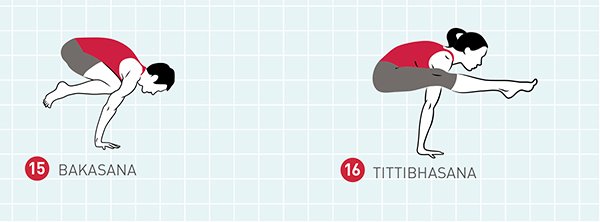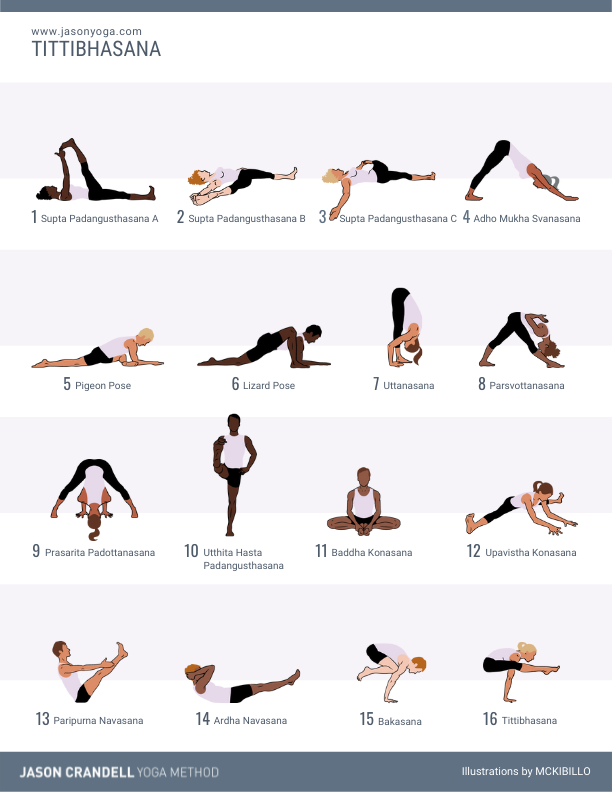In my 500-hour Trainer-Coaching Packages I’ve my college students examine Bakasana and Titthibhasana, or Firefly Pose, with the goal of studying the best way to create efficient sequences for every of those postures.
When the trainees take a look at the 2 poses side-by-side, they see one thing they normally haven’t observed earlier than: Bakasana and Tittibhasana (Firefly Pose) are almost the very same pose. Nonetheless, the one main distinction between the 2 postures has important sequencing implications. We’ll get to the yoga sequencing implications in a second. However first, let’s take a look at the similarities between the 2 poses. Take a second to match Bakasana and Tittibhasana (Firefly Pose) beneath.

Bakasana and Titthibhasana share the next similarities:
1. Each poses flex the backbone.
2. Each poses broaden the scapulae whereas strongly partaking the serratus anterior.
3. Each poses require robust core engagement, most importantly the transverse abdominus, the rectus abdominus, and the illio-psoas.
4. The shoulder joint (or gleno-humeral joint for you fact-checkers on the market) is at roughly 90 levels of flexion in each poses.
5. Each poses strongly flex the hip joints and require the adductors (internal thigh muscle tissue) to have interaction to forestall the legs from sliding down the arms.
In easy phrases, the arms, shoulders, shoulder blades, backbone, core, and hips are doing the identical factor in Bakasana and Tittibhasana.
The one important distinction between the 2 poses is that the legs are bent in Bakasana they usually’re straight in Tittibhasana. That’s all people.
However—and it is a huge BUT—straightening the legs has far-reaching implications that makes sequencing for Tittibhasana completely different than sequencing for Bakasana. While you straighten your knees in Tittibhasana (Firefly Pose) you:
1. Stretch your hamstrings. The hamstrings are contracting in Bakasana, however they’re stretching in Tittibhasana. This implies your college students want loads of hamstring preparations within the sequence that you just create.
2. Stretch and contract your adductor muscle tissue. Tittibhasana requires you to stretch the adductors because the legs open at a slight angle if you straighten the knees on this pose. On the similar time, the pose requires you to have interaction your adductors in order that your legs don’t slide down your arms. To facilitate this, your sequencing wants to incorporate each adductor opening and strengthening.
3. Interact your core (much more). In case your hamstrings and adductors are in the slightest degree tight, they may pull the load of your physique down as quickly as you begin straightening your legs. To counteract this downward pull, it’s a must to hearth up your core and create even larger carry than you do in Bakasana.
4. Interact your quads: Partaking your quads straightens your knees in Tittibhasana (Firefly Pose). Your quads additionally work along with your core to flex your hips and help the load of your pelvis. Your sequence and your verbal cueing ought to embody postures that assist your college students tune into these muscle tissue in order that they know the best way to have interaction them as soon as it’s time for Tittibhasana.
Apply the 16-pose sequence above and see how all of those layers are included. Let me know the way it goes within the remark part beneath!
See additionally Important Sequence: Bakasana
While you perceive the nuances of postures like Bakasana and Tittibhasana, you’ll be able to assist demystify these poses to your college students. Much more, you’ll be able to create logical, efficient sequences that preserve your courses recent and assist your college students do greater than they ever thought they might.
{illustrations by MCKIBILLO}

